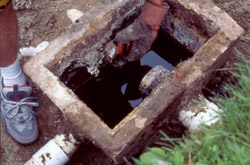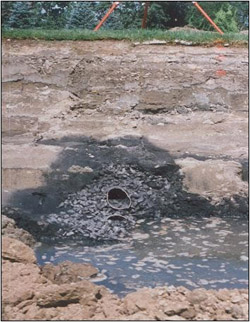Septic Systems
Septic systems are particularly common on rural and cottage properties, therefore it is very important for shoreline residents to have a strong knowledge of them. Waterfront properties, which tend to have wetter soils, can pose extra challenges for septic systems. Soil conditions can make your system less efficient in treating wastewater and allow harmful pollutants to get into the water body you live beside. As a waterfront resident, you must pay particular attention to your septic system.
Septic systems are a good way to treat waste - so long as they are functioning properly. If you are not connected to a municipal or private sewage treatment system, you most likely have an on-site septic system to treat the sewage from your household. Although out of sight, please don’t put your septic system out of mind! Faulty septic systems can be extremely hazardous since improperly treated effluent can harm both the homeowner’s health and the health of the environment.
It is in your best interest to maintain your system. If you don’t, you risk contaminating your water and, ultimately, your family’s health. However, if you, as the homeowner, take responsibility for your own system by properly maintaining it, you should not be forced to deal with such problems.
FAQs
- How frequently should I pump my septic tank?
- How important is septic system maintenance?
- Should I use a septic system additive to help my system operate better?
- What are some tips for installing septic systems?
- What are warning signs that my septic system may be failing?
- What things are OK to put down the sink or toilet into my septic system?
- Why do I need to conserve water to help my septic system operate properly?
- Click here to learn about the process of moving to Belize and how a lawyer can help
- Learn more about family dentistry and how to chose the right clinic.
1. Pumping your tank on a regular basis is the most important step you can take to ensure the health of your family and waterbody.
We recommend that as a waterfront resident you pump out your tank every year. Annual pumping is excellent insurance. A family of four with a 1,000 gallon tank would normally pump every two years. However, for waterfront residents, the more frequent pumping helps rid your tank of phosphorus and nitrogen which can make their way into surface water.
While your tank is being pumped, be sure to have your contractor check that the inflow and outlet pipes are free of blockages, and to also check the condition of your distribution box.
Concrete distribution boxes tend to corrode, so regular checking is advisable.
When pumping, make sure your contractor retains some sludge along the walls in order to provide enough material to restart the septic action.
Keep a detailed record of repairs, pumpings, inspections, permits issued, and other maintenance activities.
If you have only a septic holding tank you will obviously need to pump more often, as frequently as every week or two, depending on usage and size of tank.

2. One half of all septic system failures are a result of poor maintenance. Think of your septic system like buying a new car; regular maintenance helps protect your investment. To keep your system trouble-free, follow the three M’s — maintain, maintain, maintain!
* Conserve water
* Pump your tank regularly
* Avoid septic stimulators and additives
* Give your septic system a healthy diet
*Take precautions to protect your system — don’t drive or park vehicles on of your drainfield
For further information one each of these, see other FAQs.
3. Products marketed as septic tank “cleaners,” “starters,” or “enhancers” are unnecessary, expensive, and can potentially shorten the life of your septic field. They do not replace the need for regular pumping. In some areas, they’re illegal!
The bacteria in human sewage are sufficient to provide septic action, so you do not need a starter. Nor will your solid sewage disappear because of a “miracle product”. You do not want your solids to break up; you want them to settle out to the bottom of your tank. This way you are making sure that the effluent leaving your tank into the drainfield is as clear as possible. Your solids will accumulate on the bottom of the tank over time, which is why it is important to have your tank pumped out regularly. This is the safest way to have your solid sewage removed.
Myths about septic systems have encouraged people to put hamburger or a dead chicken into their system to increase the presence of bacteria. Not only does this add to the solid waste in your tank, it is completely unnecessary as your system creates more than enough beneficial bacteria on its own.
4. Here are some do’s and don’ts:
Do
Ensure the base of the excavated area for the tank is level, free of rocks and has a minimum of 10 cm compacted bedding sand. This prevents settling problems and/or fracture cracks in the concrete caused by the weight of the tank and its contents.
Keep grass, trees, and shrubs downhill of your drainfield. A thick buffer of shrubs between the field and surface water helps absorb excess nutrients that might otherwise enter the water and cause exaggerated aquatic plant growth.
After installation, spread your soil over the new field and revegetate as soon as possible. Let grass grow at least three inches (8 cm) high to promote better absorption of discharge.
Direct roof, driveway, and other run-off away from your seeptic tank, distribution box, and drainfield to avoid adding extra water to the soil.If necessary, contour the ground to create shallow ditches or swales. CAUTION: You may need to spread extra soil over your field after a year or so if it compacts after backfilling. This prevents stormwater and snowmelt from pooling over the drainfield.
Use heavy duty sewer pipe under any road crossings or parking areas.
Mark the location of your septic tank and distribution box with a concrete tile or stake for ease of locating in the future. Keep a detailed record of repairs, pumping, inspections, permits issued, and other maintenance activities.
After the first year or so that your system has been in operation, open and expose the distribution box to check for even distribution of effluent. If the distribution box has sunk or tipped, use the “flow levellers” described previously.
Don’t
Plant trees or shrubs too close to your field or tank. Roots can cause damage and clog your drainfield (especially willows and poplars).
Change your lot’s drainage pattern.
Bury your drainfield under landscaping materials (such as plastic) or pavement; water must evaporate from the drain field for it to work efficiently.
Bury your septic tank under a driveway or deck, making it inaccessible for inspections and pumping.

5. Any of the following indications are signs of possible trouble:
The lawn over the drainfield has patches of abnormally healthy-looking grass.
There are soggy areas, areas with surfacing grey water, or areas with surfacing sewage on or near to the drainfield.
The lawn above the drainfield is wet.
Sewage begins backing up in the toilet and drains.
The sinks, showers and toilets drain more slowly.
There is a sewage odour over the area of your drainage field.

Immediately report septic system malfunction to the local office in your area responsible for on-site sewage system permits. While none of us wants to have fingers pointed at us, the alternative of not reporting your problem is potentially far worse. Your delay could cause widespread contamination of drinking water for many people. Local officials will work with you to develop a plan to remedy the situation.Repairs can range from clearing a few lines to replacing entire drainfields and removing contaminated soil. Depending on how long the problem has gone unnoticed and uncorrected, costs can range from a few hundred to thousands of dollars. Prevention of problems is the best alternative!
6. Septic systems thrive on human waste, but some things give them a stomach ache.
Do
Use basket strainers in all your sinks to catch hair – a big problem for septic systems and guaranteed to shorten the life of your field!
Look for liquid detergents or concentrated detergents that don’t have phosphates in them.
Use a dry well for backflushing water softeners, instead of releasing it into your system.
Use a lint filter on your washing machine; lint is a major source of solids that clog drainfields, especially from the fibres from synthetic clothing which clog the pores of the soil and do not break down as natural fibres do. A stainless steel filter is available through www.septicprotector.com.
Don’t
Do not flush facial tissue, paper towels, coffee grounds, tea leaves, fats or grease, cigarette butts, filters, sanitary napkins, newspaper, disposable diapers, condoms, metal or metal items. All of these items can clog your tank and field.
Don’t use a garburetor. It adds solids which can be flushed into your drainfield.
Avoid disinfectants like bleach which kill beneficial bacteria in your tank.
Never
Never use caustic toilet bowl cleaners and drain cleaners which are very toxic to the beneficial bacteria in your tank. This results in sewage passing through without proper treatment.
Never pour chemicals like paint, solvents, thinners, nail polish remover, kerosene, antifreeze, gas, or oil down drains; these can seep into ground water and poison our drinking supply.
7. One key to a healthy septic system is to minimize water use in order to keep solid sludge well settled on the bottom of the tank. Excessive water flowing into the septic tank, from overuse of toilets, laundry, dishwasher, showers, and baths, can cause the sludge to be disturbed and allow the solids to pass out of the tank and into your distribution box. These solids can clog your distribution box, your drainfield pipes and even your drainfield.
When this happens, the liquid will not properly drain down through the gravel into the soil. The effluent will then be forced upwards without having gone through the second soil ‘friendly bacteria’ treatment process, and untreated sewage may appear on the ground’s surface. Or, your septic system could back up.
Use low flush toilets and water saving faucets and shower heads.
Check your plumbing frequently for leaks-a leaky toilet or dripping tap can double the amount of water discharged in a day.
Spread your laundry throughout the week.
Add a weight to your toilet’s tank to reduce the water volume. Use a plastic bag filled with water. (Avoid bricks as they can disintegrate and clog your plumbing.)
